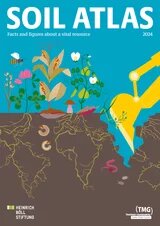
The Sahara Desert is expanding, thereby threatening millions of people’s lives and livelihoods. While many large-scale initiatives have been launched to combat desertification, most lack secure funding. Bottom-up techniques, implemented by local farmers, show how Indigenous knowledge can drive restoration.

Once lush and densely populated, the Sahara is now the world’s largest hot desert. Rainfall is scarce, with most areas receiving just 25 to 50 millimetres per year. The desert extends across northern Africa, covering over 9 million square kilometres, nearly one-third of the African continent. Despite its harsh climate, sand seas, and high dunes, the Sahara has verdant oases and lakes. It is home to a variety of species of flora and fauna, as well as around 2.5 million people.
Yet the region is under threat. The climate crisis, coupled with population growth, extensive farming, and overgrazing, have eroded the soil and degraded ecosystems. Such human activities combined with repeated droughts and dry Harmattan winds have caused the desert to expand south into the Sahel, a 6,000-kilometre belt of semi-arid savannah stretching from Senegal to Sudan. The Sahel is home to some
400 million people and provides a sanctuary for wildlife, such as the African spurred tortoise and the Saharan cheetah.
In the Sahel, desertification contributes to humanitarian crises, famine, and starvation. The number of people living on the brink of starvation in the region rose tenfold between 2019 and 2022, according to the World Food Programme. This dramatic rise can be attributed to a combination of factors, including desertification, conflict, and rising food prices. Biodiversity is declining and water bodies are shrinking. Lake Chad, a critical source of water for animals, plants, and over 30 million people, is drying up.
The Great Green Wall is one of many efforts to regreen the Sahara and Sahel. Led by African governments, this initiative seeks to stop the desert’s advance by restoring the fertility of degraded agricultural and pastoral lands. It uses a range of approaches: tree planting, assisted natural regeneration (which supports the growth of naturally germinated seedlings), water conservation, and sustainable land management. However, there have been setbacks. Many trees have died due to lack of water or poor adaptation to local conditions, and scientists have expressed concerns about the ecological impacts of introducing non-native species. However, the Great Green Wall has since been refined to emphasise sustainable and locally adapted practices.
Progress has been made in raising global awareness and generating funding for restoration efforts on the ground. One such initiative is the Regreening Africa programme, which has engaged over 500,000 households across eight African countries in land restoration efforts. This programme provides training in sustainable land management, tree planting, climate-smart agriculture, and soil and water conservation techniques.
Yet many challenges remain. According to the United Nations, the Great Green Wall initiative needs at least another 33 billion US dollars in funding to achieve its 2030 target. While many governments have pledged support, action on the ground is hampered by inadequate funding from international donors and Sahel countries, many of which are beset by political tensions, instability, and terrorism.
Away from these large, public programmes, local farmers have initiated bottom-up projects that have seen considerable success. A prominent figure in this movement was Yacouba Sawadogo, a farmer from Burkina Faso who single-handedly planted over 25 hectares of forest with over 60 species of trees and shrubs. He used the ancient zaï technique, where small pits filled with manure and dead vegetation capture scarce rainwater and concentrate soil nutrients. Trees and crops are then planted in the pits. This technique improves yields, enhances soil fertility, and helps farmers adapt to climate crisis. With support from non-governmental organisations, the zaï technique has improved food security for some 3 million people in Burkina Faso, raised household gross incomes by an average of 18 to 24 percent, reversed environmental degradation and desertification on 6 million hectares of land, and resulted in the planting of around 200 million new trees.
Farmers across the Sahara and Sahel are tackling land degradation by putting their Indigenous knowledge into practice. Farmer-managed natural regeneration is another similar approach, which involves farmers nurturing trees in degraded areas to help vegetation recover. This helps communities adapt to the climate crisis by boosting agricultural production even in drought years, which in turn increases incomes and strengthens community cohesion. In Niger, trees planted without the participation of local farmers often fail to thrive; however, those grown by local farmers have a significantly higher survival rate. Over 6 million hectares – about 50 percent of the country’s cultivated area – have been restored in this way. In neighbouring Mali, village self-help groups implement traditional techniques combining agriculture and forestry. These techniques spread through learning exchanges among farmers, local radio programmes, and contests rewarding the most successful farmers.
It is clear that a combination of approaches is needed to halt the advance of the Sahara. The problem is too big for communities to tackle alone, and too complex for national and international actors to manage without the input of local farmers.

